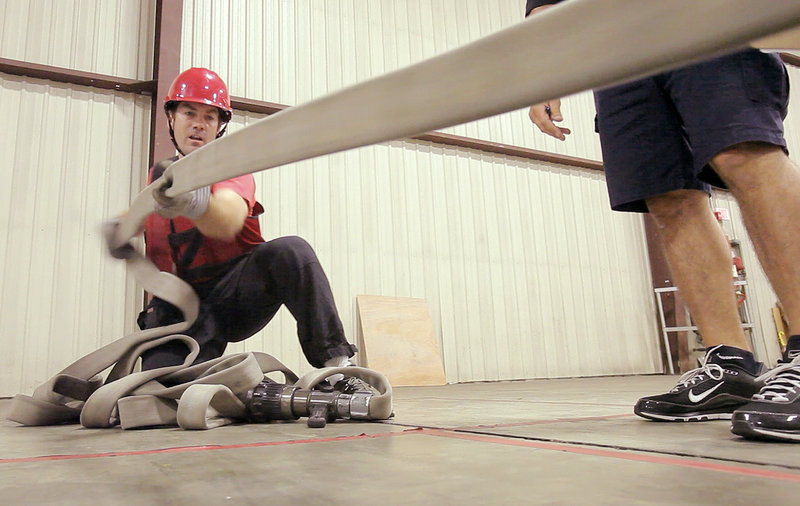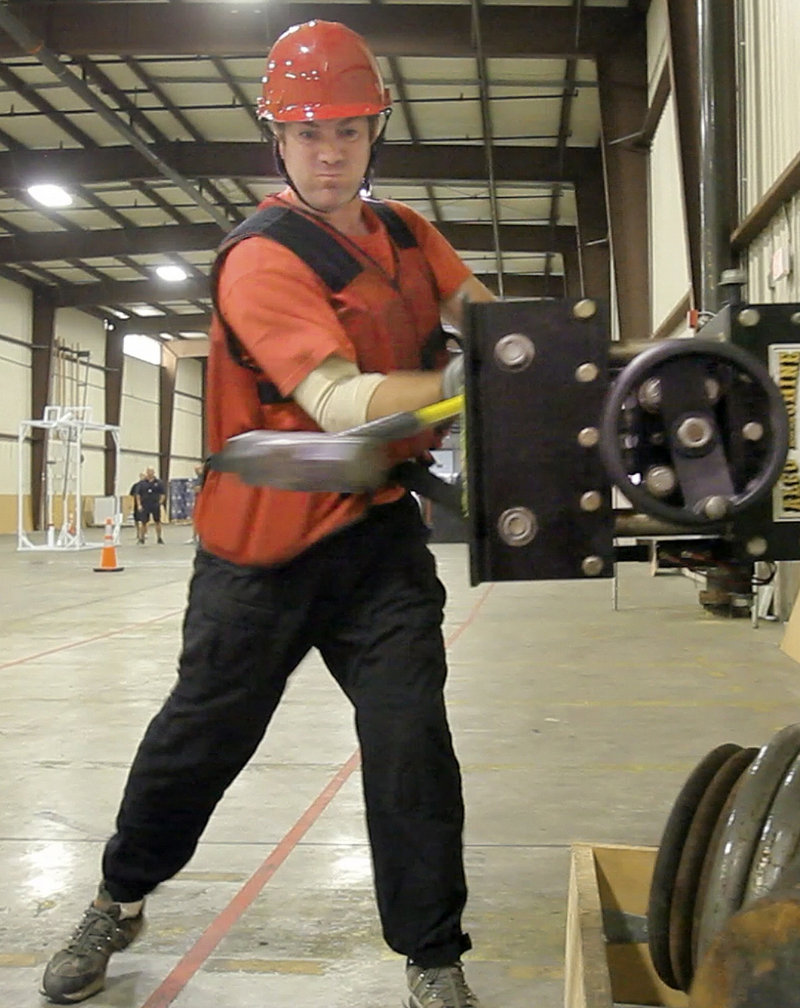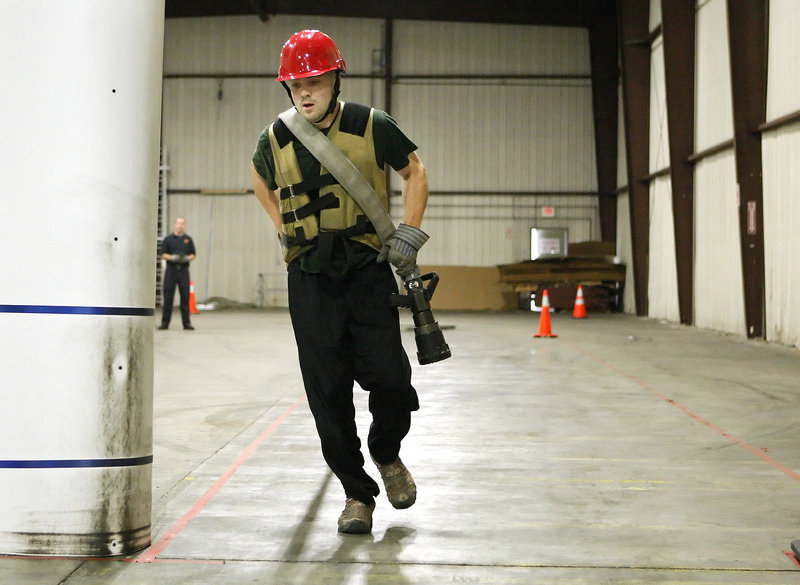PORTLAND – “One minute 30 — you’re halfway there.”
I kept my head down, focusing on the treads of the stair machine, the 75 pounds of extra weight on my shoulders making my calves burn.
I was taking the Candidate Physical Ability Test, which men and women who want to be Portland firefighters must pass. The firefighter at the test’s first station was letting me know how much longer I would have to walk stairs.
I was halfway through the station, the “monster” as one firefighter proctor called it. Coming at the start of the eight-station test, it’s where most candidates who fail punch out. It’s cardio, it’s leg strength, it’s balance — all in one.
So hearing that I was halfway through wasn’t good news. I was hoping that the next time the proctor spoke up, there would be a minute left, not a minute and a half.
In this latest round of tests, 55 candidates have taken the CPAT and 40 have passed, completing the course in less than 10 minutes and 20 seconds. On Wednesday morning, when I took it, one man fell prey to the monster and two others — firefighters in other communities — passed.
Anyone who wants to take the physical test must pass the written test. Anyone who passes both gets on Portland’s waiting list of candidates. There are no openings now, but the city has to maintain a waiting list, said city spokeswoman Nicole Clegg, so there’s always a pool of people who could join the department if needed. The next step for anyone on the list is a job interview.
The department has 216 firefighters in nine companies around the city. New firefighters start at $584.64 a week, plus benefits.
The city invited the media to cover the tests Wednesday, and said anyone who wanted to try the CPAT was welcome. I jumped at it. (I just had to convince my editor).
My grandfather was a firefighter in Pennsylvania. My dad is a call/volunteer firefighter in Madawaska. He joined the department in 1976. It was always a big part of his life, and mine, too.
When I was a kid, we would ride on the trucks in the parades. I remember going to musters to see the guys (they were all guys) compete in games. We had family days and picnics.
When I was older, I would help out with controlled burns, as the department set fire to dry fields in the spring so they couldn’t “accidentally” catch fire later and cause damage.
I wish I could be a firefighter. But I have always lived in communities with paid departments — not volunteers. And, as a reporter, there would be a general conflict of interest in being a member of something that the newspaper has to cover.
But I could at least try the test, to see if I had at least a bit of what it takes to be a firefighter.
I asked Dad for advice on the test. He was succinct: “Yeah — don’t take it.”
Thanks, Dad.
He gave me a few tips, and we talked about the time limit of 10 minutes, 20 seconds. That’s a short time to get a lot done.
“If it was too fast, they wouldn’t have any firefighters,” Dad said. “It can be done, just listen to the instruction.”
Robert Newberry, 31, of Raymond passed the course just as I was getting ready to take it. He’s a call firefighter in Raymond and would like to be a firefighter full time. He enjoys the work, and the company of other firefighters.
“You meet a lot of good people in this line of work,” he said.
His advice echoed my dad.
“It’s not impossible,” he said. “You don’t have to be in ironman condition, but you do have to train for it.”
The course, laid out in a warehouse on Read Street, was designed to simulate physical stresses that a firefighter would encounter during a fire. The stair machine, and the 75 pounds of weight, is like carrying a hose up flights of stairs while wearing bunker gear and breathing tanks.
As in many professions (not mine, thankfully), the physical component can be demanding.
“Industrial athletes,” said Capt. John Cannon, “that’s what we’re expected to do.”
I finished the stairs, breathing hard at the end, but not dead.
Firefighter John Hardy was my guide, taking me along the red-taped course from station to station, reminding me what needed to be done. I dropped 25 pounds off my shoulders, keeping the 50-pound weight vest on.
We walked briskly to the hose pull — the one place in the course where a candidate can run. I grabbed the hose nozzle and ran 100 feet, then pulled the hose in.
The tool-carry station was next. Grab two buzz saws, carry them 85 feet. Check.
Next station: ladders. Raise one onto the wall, walking it up rung by rung. Extend another with a halyard, then lower it. Check.
By this time, I’m thirsty — really dry.
I’m not a triathlete by any stretch, but I keep in shape. I mountain-bike several times a week, hike when I get the chance. I’m 38 and I weigh 210. But when I’m exercising, I’m always hydrating — I never get dry, because I’ve always got a water pack on my back or a water bottle in easy reach.
But candidates just sweat through this test, and hydrate after it.
Next station: forcible entry. This was a snap — I basically had to swing a 10-pound sledge onto a target until I had moved a force-measuring machine enough to sound a buzzer.
Steady walk down to the search-and-rescue station, a long black cubical tube, pitch-black inside. Here, I actually used some of my dad’s advice, crawling in, keeping a hand on the wall as I worked under, over and around obstacles.
Pop out, walk to the next station, rescue. I had to grab a 175-pound dummy and drag it 70 feet by a harness.
Last station: pike pole. Grab the pole, which has a point and a hook at the end, push it up onto a weighted plate, then pull down on a weighted catch. Push three times, pull five times. Do that four times in all.
And done.
Nine minutes, 16 seconds. I did it — and didn’t totally embarrass myself.
My wife and two little boys were there to watch, which was very cool. Both boys got to crawl through the search-and-rescue tube, which they enjoyed.
My 6-year-old, however, was disappointed that Dad didn’t have to face real fire in the test. Thanks, kid.
When I got back to the office, I called my Dad to let him know I’d passed. Mom said he wasn’t home.
He was out on a fire call.
Staff Writer Matt Wickenheiser can be contacted at 791-6316 or at:
mwickenheiser@pressherald.com
Send questions/comments to the editors.






Comments are no longer available on this story